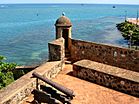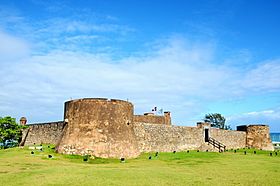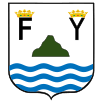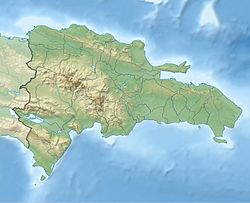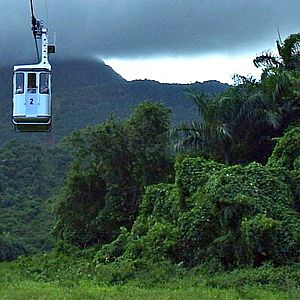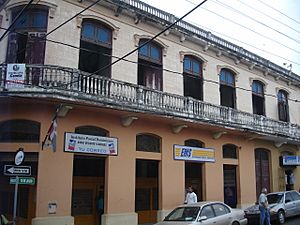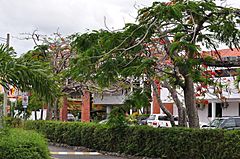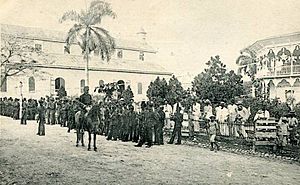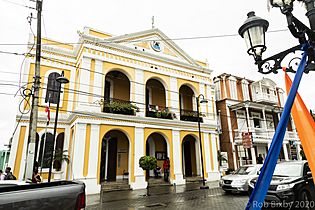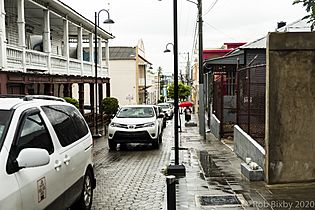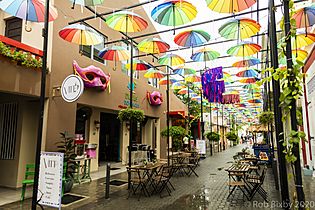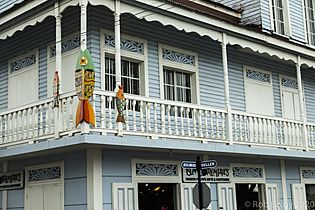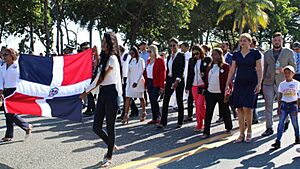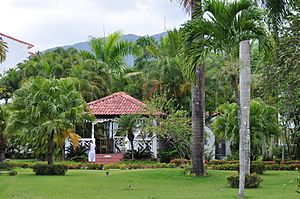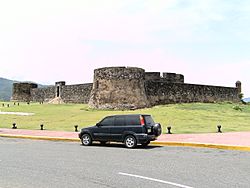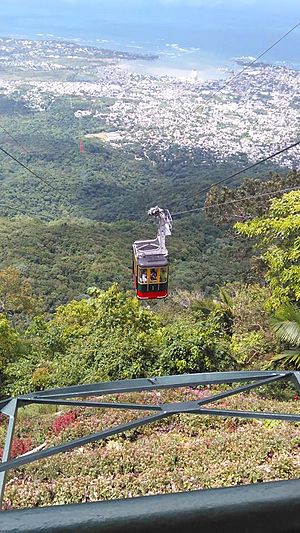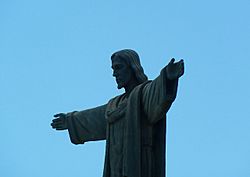Puerto Plata, Dominican Republic facts for kids
Quick facts for kids
Puerto Plata
San Felipe de Puerto Plata
|
|||
|---|---|---|---|
|
City
|
|||
|
From the top: Panoramic, Downtown, Fort, Street, Christ the Redeemer and San Felipe fort
|
|||
|
|||
| Nickname(s):
La tacita de plata (the little silver cup) La Novia del Atlántico (The Bride of the Atlantic)
|
|||
| Country | Dominican Republic | ||
| Province | Puerto Plata | ||
| Founded | 1502 | ||
| Municipality since | 1844 | ||
| Area | |||
| • Total | 509.01 km2 (196.53 sq mi) | ||
| Elevation | 8 m (26 ft) | ||
| Population
(2012)
|
|||
| • Total | 329,419 | ||
| • Density | 647.176/km2 (1,676.178/sq mi) | ||
| • Demonym | Puertoplateño(a) | ||
| Time zone | UTC-04:00 (AST) | ||
| Distance to – Santo Domingo |
215 km (134 mi) |
||
| Municipal Districts | 2 |
||
Puerto Plata, also known as San Felipe de Puerto Plata, is a large city on the coast of the Dominican Republic. It is the capital city of the Puerto Plata region. The city is an important port for trade.
Puerto Plata has many popular resorts like Playa Dorada and Costa Dorada. These are located east of the main city. There are 100,000 hotel beds in the city for visitors. You can also ride the first aerial tramway (cable car) in the Caribbean here. It takes you up to Pico Isabel de Torres, a mountain that is 793 meters (2,600 feet) high.
The city's history began in the early 1500s. Spanish settlers built a small town there. For many years, it was the main trading port on the island. In 1605, the city was emptied and destroyed by order of Philip III of Spain. This was done to stop attacks from English pirates. About 100 years later, new farmers from the Canary Islands came to live there. From 1822 to 1844, the city was controlled by Haiti. After 1844, the Dominican Republic became independent, and Puerto Plata started to grow again as a port.
Many buildings in Puerto Plata today have a Victorian style. This is because the city was rebuilt starting in 1865. By the late 1800s, Puerto Plata was very important for its culture, social life, trade, and economy.
Contents
Geography and Nature
Puerto Plata is built on land that rises steeply from the sea. This means you can see almost the whole city from the port. The Atlantic Ocean is to the north, and the Isabel de Torres hill is to the south and southwest.
The city has a natural harbor because it was built around a small bay. Puerto Plata is the biggest city on the northern coast. It includes smaller areas like El Cupey, Maimón, and Sabana Grande.
The Isabel de Torres mountain is about 5 kilometers (3 miles) southwest of the city. It is part of the Cordillera Septentrional mountain range. The mountain reaches a height of 800 meters (2,625 feet) above sea level. You can drive to the top of the mountain using the Don José Ginebra highway. The area around the mountain is a National Monument. It covers about 20 square kilometers (7.7 square miles). At the very top, there is a tropical botanical garden. It is about 7 acres (28,000 square meters) in size and has 600 different types of tropical plants.
Rivers and Streams
The most important rivers in the area are Camú del Norte, San Marcos, and Muñoz. There are also streams like Fú, Blanco, and Culebra.
Climate
Puerto Plata has a tropical climate. This means it has hot, somewhat wet summers and warm, very wet winters. This is because of its location near the equator. Cold fronts in winter bring humid and wet weather.
City Seal
In 1508, the Spanish king gave the cities of Hispaniola their own seals and rights. The seal for "Puerto de Plata" was described as a silver shield with a green mountain. On the mountain were golden letters "F" and "Y" with crowns. These letters stood for King Fernando and Queen Ysabel (Isabel) of Spain.
History of Puerto Plata
Puerto Plata has been an important place since the early days of the New World. Historians are not sure of the exact year it was founded, but it was likely around 1502.
Christopher Columbus saw the mountain and called it Monte de Plata (Silver Mountain). He noticed that the top was often foggy, making it look silver. This is how the port got its name. The city was designed by Christopher Columbus and his brother Bartolomé in 1496. In its early years as a Spanish colony, Puerto Plata was the main trading port on the island.
Around 1555, the city became less important as a port. It was often visited by pirates. In 1605, King Philip III of Spain ordered the city to be emptied and destroyed. This was to stop English pirates from using it.
About 100 years later, farmers from the Canary Islands came to live there and rebuilt the town. During the Quasi-War (a fight between France and the United States), American soldiers attacked a French ship and the Fortaleza San Felipe in Puerto Plata.
From 1822 to 1844, the city was under Haitian control. After 1844, the Dominican Republic became independent. Puerto Plata then began to grow again as a trading center.
Many European immigrants came to the city, which shaped its culture and society. In 1863, during the Dominican Restoration War, the city was completely destroyed. Starting in 1865, the current Puerto Plata was built. This is why many buildings have a Victorian style. By the end of the 1800s, Puerto Plata was very important for its culture, society, trade, and economy.
Economy
The city of San Felipe de Puerto Plata is known for its agribusiness (farming and food processing) and tourism. These are big parts of the country's economy. Other ways people earn money include managing the port, building ships, fishing, and making textiles (cloth).
The port is very important for the economy of the whole country. It welcomes cruise ships and cargo ships. These ships export farm products and goods made in the region's duty-free zones. A new cruise terminal called Taino Bay opened in December 2021. It is closer to the city than the older Amber Cove terminal.
Culture
Carnival celebrations in Puerto Plata have been happening since the late 1800s. A main character in the carnival is the "devil cojuelo." In Puerto Plata, this character is called Taimáscaro. Its masks show old Taíno gods. The costume has elements from Spanish and African cultures, with colorful ribbons on its arms. It also includes shells from the Atlantic Ocean, showing the local identity of Puerto Plata.
These celebrations take place in February and March along the Jetty avenue and city streets. People enjoy parades, music, dances, and art that show the city's culture. Each year, a "King Momo" is chosen to represent the city's traditions.
Architecture
Puerto Plata is famous for its Victorian style buildings. This style mixes with other types of architecture, making the city's look very interesting.
One old style is from the colonial times. The Fortress San Felipe is a good example of this. Another style is the traditional one, which came from the Canary Island settlers. This style includes balconies, and the Guinea bridge from 1879 is an example.
The Victorian style became popular after the Dominican Restoration War. It was brought by immigrants from France, Italy, Germany, and England. This style was used for homes and public buildings. It gives Puerto Plata its unique look.
Later, modern architecture appeared because of the American occupation (1916-1924) and under Trujillo. This style used cement blocks for building.
Downtown Puerto Plata
Education
Many important educators have shaped the school system in Puerto Plata. These include Antera Mota, Emilio Prud'Homme, and Ana Isabel Jiménez.
Today, San Felipe de Puerto Plata has 182 schools. About 67% of these are public schools, and 39% are private.
There are 29,279 students in the city. This includes students in early childhood, elementary, middle, and high school. There are also programs for adults and special education.
Besides schools, there are four universities that offer different technical and higher education degrees:
- Pontificia Universidad Católica Madre y Maestra (PUCMM)
- Universidad Organización y Método
- Universidad Tecnológica de Santiago (UTESA)
- Centro Universitario Regional del Atlántico de la Universidad Autónoma de Santo Domingo (CURA-UASD)
Sports
Since the 1950s, the main sports group in Puerto Plata has been the League of the Atlantic. It was started on August 16, 1958. This group holds events all year, mostly baseball games. Later, basketball was added. Many clubs joined, like the Gustavo Behall and Hugo Kunhard clubs.
Since the 1970s, school sports events have been very popular. Students compete in different sports throughout the year. Also, at Golden Beach, the Club Golf Puerto Plata tournament is held regularly. Many top golf players from the local area, the country, and other countries take part.
Tourism
The main tourist areas in Puerto Plata are Playa Dorada and Costa Dorada. These are located east of the city. There are 100,000 hotel beds in the city, many of which are in "all-inclusive" resorts.
Puerto Plata is served by Gregorio Luperón International Airport. It is about 15 kilometers (9 miles) east of the city, near the town of La Union.
In 2015, Carnival Cruise Line opened a new cruise port called Amber Cove. It cost $85 million to build.
Fort San Felipe
The fort is the most important old building in Puerto Plata. The city grew up around it. In 1540, people asked for a fortress to be built. Construction began in 1549 and was finished in 1577. The fort was built to protect the city from attacks by bandits, privateers, and French and English pirates. It was named after King Felipe II, who was king when it was finished. In 1980, it was named a national monument.
Ocean World
Ocean World is an adventure park located near the reefs of Cofresí Beach. It has the world's largest man-made dolphin habitat.
This park is a major tourist attraction. It is the biggest and most complete park of its kind in the Caribbean. More than 45 million dollars were invested in this project. It includes a yacht marina, beaches, and forests. You can also see fish, colorful birds, a casino, and Malayan tigers.
Ocean World is part of a larger tourist area on the north coast of the Dominican Republic.
Museums
Museo del Ámbar: This museum was founded in 1982 by the Costa family. It is located in the Villa Bentz, which was a very elegant hotel in 1918. This museum is considered the first Amber Museum in the Dominican Republic. It is also an important historical building in the city.
La Zona Colonial (Victorian Houses): The Victorian style of building began in Puerto Plata around 1857. This style came from England and was named after Queen Victoria. It spread around the world and was seen as very modern.
The main feature of this style was using wood in artistic ways to build homes. From that time, Puerto Plata developed its unique architectural look. The rise of these Victorian houses in the 1870s created a special style in the city, now known as Puerto Plata's Victorian architecture.
El Faro (The Lighthouse)
The cast-iron lighthouse was built in 1879. It has a tower on a stone base with Doric columns. It stands 137 feet (42 meters) above sea level. Because it is on the coast, the iron suffered from corrosion (rust). In 2000, it was added to the 2000 World Monuments Watch list because it was in poor condition. Funds were provided for its repair, which was finished in 2004. After the lighthouse was fixed, the area around it was also improved.
Teleférico (Cable Car)
The Teleférico cable car opened in 1975. It was built in Italy. It can carry 17 people and takes eight minutes to go up and down the mountain. An electric system moves it, controlled by an operator at the bottom station. The cable car has glass walls, giving visitors a great view of the city as they go up or down. The mountain top is 2,555 feet (779 meters) above sea level. Visitors can see a garden with 215 types of plants, gift shops, and a restaurant with Dominican food.
Beaches
Puerto Plata has beautiful beaches with golden sands and mountains. The water is often a bright turquoise color from the sun's reflection. These beaches are known for their lovely views, rocks, waves, and sand. Many of them, like La Poza del Castillo, Cofresí, and Playa Dorada, hold special memories and traditions. The beaches are one of the city's main attractions for tourists.
Pico Isabel de Torres Mountain
On the 739-meter (2,425-foot) high mountain Pico Isabel de Torres, you'll find a botanical garden. There is also a smaller copy of the famous Christ the Redeemer statue from Rio de Janeiro. Even though the statue is smaller, the mountain itself is taller than the one in Rio. The roads leading up the mountain can sometimes be hard to use because of heavy rain.
Transportation
Puerto Plata is served by Gregorio Luperón International Airport. This airport has flights from 13 passenger airlines and 3 cargo airlines. The Port of Puerto Plata is the main trading port on the northern coast of the Dominican Republic.
Famous People from Puerto Plata
- Ulises Heureaux and Antonio Imbert – former presidents of the Dominican Republic
- Al Horford – a current NBA basketball player
- Chris Duarte – a current NBA basketball player
- Tito Horford – a former NBA basketball player and Al Horford's father
- Arthur Lithgow – an American-Dominican actor and director, born in Puerto Plata in 1915
- Gregorio Luperón – a former president of the Dominican Republic
- Carlos Martínez – a current MLB baseball player
- Carlos Felipe Morales – a former president of the Dominican Republic
- Emilio Prud'Homme – wrote the "National Anthem of the Dominican Republic"
- José Fermín – a current MLB baseball player
- Oscar Taveras – an MLB baseball player (died in 2014)
- Tokischa – a rapper (born in 1997)
Images for kids
See also
 In Spanish: Puerto Plata para niños
In Spanish: Puerto Plata para niños




